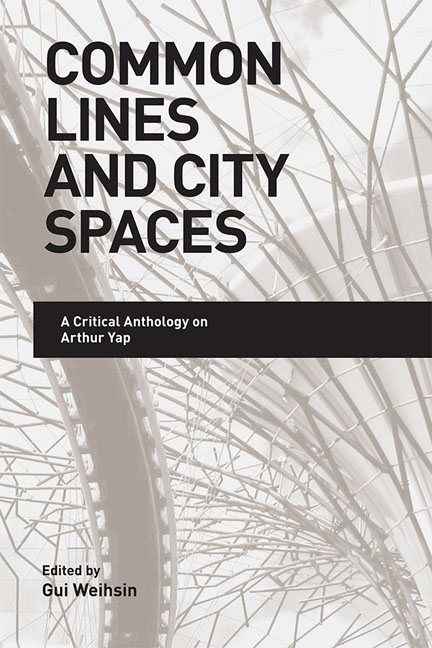Book contents
- Frontmatter
- Contents
- Acknowledgements
- About the Contributors
- 1 Common Lines and City Spaces: Introduction
- 2 The Transformation of Objects into Things in Arthur Yap's Poetry
- 3 “the same tableau, intrinsically still”: Arthur Yap, Poet-Painter
- 4 “go to bedok, you bodoh”: Arthur Yap's Mapping of Singaporean Space
- 5 On Places and Spaces: The Possibilities of Teaching Arthur Yap
- 6 Arthur Yap's Ecological Poetics of the Daily
- 7 “except for a word”: Arthur Yap's Unspoken Homoeroticism
- 8 “a long way from what?”: Folkways and Social Commentary in Arthur Yap's Short Stories
- Index
- Plate section
2 - The Transformation of Objects into Things in Arthur Yap's Poetry
Published online by Cambridge University Press: 19 May 2017
- Frontmatter
- Contents
- Acknowledgements
- About the Contributors
- 1 Common Lines and City Spaces: Introduction
- 2 The Transformation of Objects into Things in Arthur Yap's Poetry
- 3 “the same tableau, intrinsically still”: Arthur Yap, Poet-Painter
- 4 “go to bedok, you bodoh”: Arthur Yap's Mapping of Singaporean Space
- 5 On Places and Spaces: The Possibilities of Teaching Arthur Yap
- 6 Arthur Yap's Ecological Poetics of the Daily
- 7 “except for a word”: Arthur Yap's Unspoken Homoeroticism
- 8 “a long way from what?”: Folkways and Social Commentary in Arthur Yap's Short Stories
- Index
- Plate section
Summary
Like William Butler Yeats and Gertrude Stein, Arthur Yap, whose work is also regarded as modernist in theme and style, expressed a fascination with things. For W.B. Yeats, in his famous poem “The Second Coming”, it seems as if all things — social norms, cultural values, political aspirations — associated with European civilization had fallen apart and were ruined in the wake of World War I, as seen in the apocalpytic tenor of the oft-quoted line “Things fall apart; the centre cannot hold” (1956, p. 184). Gertrude Stein, on the other hand, offers a more optimistic outlook on things, claiming that “[c]ontinuous present is one thing and beginning again and again is another thing. These are both things. And then there is using everything” (2004, p. 25); Stein's compositional craft takes up everything around oneself as suitable material for the poetic imagination. And then there is Arthur Yap, whose treatment of things expresses a sympathetic yet critical sensibility, observing how “some things remain / some things pass, / some things are tired” (The Space of City Trees, 2004, hereafter Space, p. 4), and pointing to how we are often caught up in “a habit by which the world moves” such that “people will not look at the centre of things” (p. 78). In his poetry Yap personifies things, calmly observing how they come, go, or grow weary; at the same time, he calls things out to us, drawing our attention to our habitual distraction and unwillingness to look closely at them. And perhaps, Yap suggests, this unwillingness or inability to pay close attention stems from the way in which Singaporeans have grown used to treating what they have around them as objects rather than as things.
This chapter argues that Arthur Yap's poems take a “thing-like” approach towards the landscape, people, and bits and pieces of everyday life that make up Singaporean society after the country's independence in 1965. By a thing-like approach, I mean that Yap's poetry actively transforms what we would normally think of as common and functional objects with a set or defined utility into strange and multifaceted things. The representation of things in contemporary literature and culture is a subject on which literary and cultural critic Bill Brown has written at length.
- Type
- Chapter
- Information
- Common Lines and City SpacesA Critical Anthology on Arthur Yap, pp. 14 - 41Publisher: ISEAS–Yusof Ishak InstitutePrint publication year: 2014

